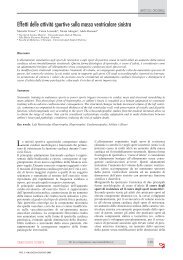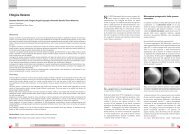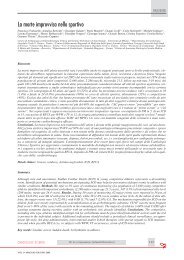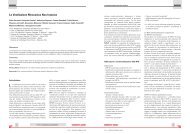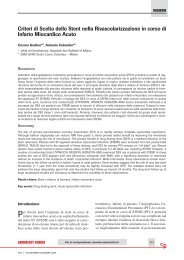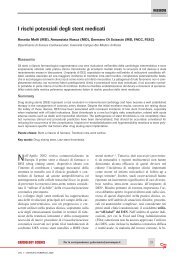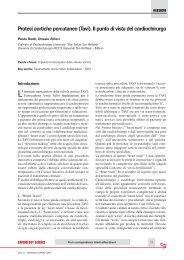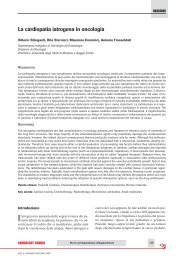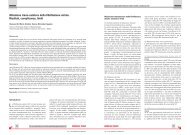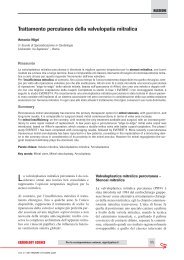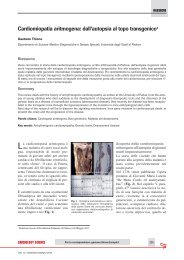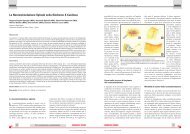La valutazione della Riserva di Flusso Coronarico - sicoa
La valutazione della Riserva di Flusso Coronarico - sicoa
La valutazione della Riserva di Flusso Coronarico - sicoa
Create successful ePaper yourself
Turn your PDF publications into a flip-book with our unique Google optimized e-Paper software.
METODICHE DIAGNOSTICHE<br />
Luigi Ferrara et Al.<br />
<strong>La</strong> <strong>valutazione</strong> <strong>della</strong> <strong>Riserva</strong> <strong>di</strong> <strong>Flusso</strong> <strong>Coronarico</strong>:<br />
un valore aggiunto per il laboratorio <strong>di</strong> ecostress per la Ricerca dell’Ischemia Inducibile<br />
METODICHE DIAGNOSTICHE<br />
zione <strong>della</strong> RFC, in<strong>di</strong>pendentemente dalla sintomatologia,<br />
ogni sei mesi proprio per monitorare nel<br />
tempo il valore <strong>di</strong> RFC, in modo da sottoporre precocemente<br />
il paziente ad esame coronarografico.<br />
Sindrome coronarica acuta<br />
<strong>La</strong> semplice visualizzazione basale dei rami perforanti<br />
che originano dall’IVA al color-Doppler dopo<br />
infarto anteriore sottoposto a trombolisi è <strong>di</strong> per sé<br />
in<strong>di</strong>ce <strong>di</strong> pervietà dell’IVA, <strong>di</strong> avvenuta riperfusione<br />
e <strong>di</strong> recupero contrattile nel tempo, con una sensibilità<br />
dell’86%, una specificità del 98% ed un’accu -<br />
ratezza <strong>di</strong>agnostica del 98% 44 . Non sono molti gli<br />
stu<strong>di</strong> che hanno valutato l’utilità <strong>della</strong> RFC nell’identificare<br />
il recupero contrattile dopo infarto miocar<strong>di</strong>co,<br />
così come non molto chiaro è il momento in<br />
cui effettuare lo stu<strong>di</strong>o <strong>della</strong> RFC dopo infarto, visto<br />
le molteplici influenze anatomiche e funzionali che<br />
l’evento acuto può avere sul microcircolo coronarico.<br />
Alcuni aspetti relativi al pattern <strong>di</strong> flusso coronarico<br />
basale, però, sono interessanti nell’identificare<br />
il no-reflow dopo rivascolarizzazione. Un rapido<br />
tempo <strong>di</strong> decelerazione <strong>di</strong>astolica <strong>della</strong> velocità <strong>di</strong><br />
flusso, una ridotta velocità <strong>di</strong> flusso sistolico ed un<br />
precoce flusso sistolico retrogrado sono espressione<br />
<strong>di</strong> no-reflow dopo riperfusione 45, 46 ; un tempo <strong>di</strong> de -<br />
ce lerazione <strong>di</strong>astolica < 185 msec dopo angioplastica<br />
primaria evidenziato entro 24 ore dall’evento<br />
acuto identifica il no-reflow meglio <strong>di</strong> altri in<strong>di</strong>ci<br />
solitamente impiegati quali l’ECG, lo score TIMI ed<br />
il picco <strong>di</strong> CPK-MB 47 ; al contrario un tempo <strong>di</strong><br />
decelerazione <strong>di</strong>astolica > 600 msec dopo 1 giorno<br />
dall’evento acuto pre<strong>di</strong>ce il recupero funzionale ad<br />
un mese 45 . In uno stu<strong>di</strong>o recente, il flusso sistolico<br />
retrogrado ( 10 cm/sec e 60 msec) evidenziato<br />
48 ore dopo la riperfusione ha un valore pre<strong>di</strong>ttivo<br />
del 100% nell’identificare l’assenza <strong>di</strong> recupero<br />
funzionale dopo infarto del miocar<strong>di</strong>o 46 . Sebbene<br />
alcuni critichino l’atten<strong>di</strong>bilità <strong>di</strong> questi dati 48 , in<br />
quanto questi pattern potrebbero essere il risultato <strong>di</strong><br />
artefatti <strong>di</strong> movimento del muscolo car<strong>di</strong>aco, riteniamo<br />
che comunque possano essere <strong>di</strong> ausilio perché<br />
aggiungono una informazione in più agli altri<br />
in<strong>di</strong>ci <strong>di</strong> riperfusione ormai noti.<br />
By-pass aortocoronarico<br />
<strong>La</strong> pervietà dei by-pass aortocoronarici e delle loro<br />
anastomosi può essere valutata me<strong>di</strong>ante color-Dop -<br />
pler trans toracico. Il flusso coronarico <strong>di</strong>stalmente<br />
al graft è simile ad un flusso coronarico normale con<br />
la componente <strong>di</strong>astolica predominante su quella<br />
sistolica. In caso <strong>di</strong> ostruzione del graft la componente<br />
<strong>di</strong>astolica del flusso si riduce o scompare. <strong>La</strong><br />
RFC fornisce informazioni aggiuntive in quanto<br />
un’im portante riduzione <strong>della</strong> RFC (< 2 per l’arteria<br />
mammaria interna e < 1,6 per il graft venoso) pre<strong>di</strong>ce<br />
in maniera accurata la stenosi 49 . Ci possono essere<br />
nella <strong>valutazione</strong> <strong>della</strong> RFC fattori con fondenti<br />
legati a competizione <strong>di</strong> flusso tra la coronaria nativa<br />
ed il graft, per cui, in caso <strong>di</strong> by-pass aor to -<br />
coronarico, è preferibile valutare la RFC <strong>di</strong>stalmente<br />
alla coronaria nativa ed a valle dell’anastomosi<br />
del graft 50 .<br />
Valore prognostico <strong>della</strong> RFC<br />
Diversi stu<strong>di</strong> hanno evidenziato come la presenza <strong>di</strong><br />
una ridotta RFC sia associata ad una prognosi negativa,<br />
in<strong>di</strong>pendentemente dalla presenza o meno <strong>di</strong><br />
malattia coronarica. Nei pazienti con car<strong>di</strong>omiopatia<br />
<strong>di</strong>latativa non ischemica la presenza <strong>di</strong> una RFC<br />
< 2 con <strong>di</strong>piridamolo si associa ad una prognosi sfavorevole<br />
in un periodo <strong>di</strong> osservazione <strong>di</strong> 22 mesi 51 .<br />
Inoltre nei pazienti con malattia coronarica sospetta<br />
o nota, un eco stress negativo e la presenza <strong>di</strong> una<br />
RFC < 1,92 con <strong>di</strong>piridamolo erano associate ad una<br />
prognosi peggiore, al contrario dei pazienti che avevano<br />
una RFC normale 52 . Anche nei cuori trapiantati<br />
la presenza <strong>di</strong> una ridotta RFC (< 2,6 con adenosina)<br />
si associa ad un maggior rischio <strong>di</strong> eventi car<strong>di</strong>aci<br />
avversi in un follow-up me<strong>di</strong>o <strong>di</strong> 19 ± 5 mesi 53 .<br />
Non è chiaro se in questi pazienti la ridotta RFC<br />
esprima una <strong>di</strong>sfunzione del microcircolo o se la<br />
correzione <strong>di</strong> quest’ultimo possa migliorare la prognosi,<br />
così come non c’è generale accordo sul fatto<br />
nei pazienti con coronarie normali la presenza <strong>di</strong><br />
una ridotta RFC debba associarsi ad una prognosi<br />
sfavorevole 54 . Questo è un aspetto interessante, an -<br />
cora oggetto <strong>di</strong> stu<strong>di</strong>o. Noi pensiamo che la ridotta<br />
RFC in paziente con coronarie normali, in alcuni<br />
casi pos sa non esprimere in maniera reale la <strong>di</strong>sfunzione<br />
del microcircolo coronarico, non fosse altro<br />
per il fatto che quest’ultimo è posto valle del segmento<br />
coronarico che stiamo analizzando con il<br />
Doppler pulsato; inoltre, la <strong>di</strong>agnosi <strong>di</strong> <strong>di</strong>sfunzione<br />
del microcircolo, attualmente, è fatta solo a posteriori<br />
dopo l’ese cu zione <strong>di</strong> una coronarografia risultata<br />
negativa. Ulte riori stu<strong>di</strong>, per ora solo sperimentali<br />
55, 56 , potrebbero chiarire se esista un metodo <strong>di</strong><br />
stu<strong>di</strong>o ecocar<strong>di</strong>ografico più obiettivo e reale del<br />
microcircolo coronarico, probabilmente me<strong>di</strong>ante<br />
l’impiego del contrasto che consente la <strong>valutazione</strong><br />
<strong>di</strong>retta <strong>della</strong> perfusione miocar<strong>di</strong>ca 57 e <strong>della</strong> β-riserva<br />
coronarica a livello <strong>di</strong> un determinato segmento<br />
<strong>di</strong> muscolo car<strong>di</strong>aco 56 .<br />
Conclusioni<br />
Bibliografia<br />
<strong>La</strong> <strong>valutazione</strong> delle RFC me<strong>di</strong>ante Ecocolor Dop -<br />
pler trans toracico rappresenta una meto<strong>di</strong>ca non<br />
invasiva, <strong>di</strong> basso costo, altamente fattibile, riproducibile<br />
ed accurata dopo un periodo <strong>di</strong> training, che<br />
fornisce informazioni preziose sulla fisiopatologia<br />
coronarica. Il suo impiego <strong>di</strong>agnostico nella patologia<br />
coronarica monovasale, nei soggetti sottoposti<br />
ad angioplastica coronarica per la <strong>di</strong>agnosi <strong>di</strong> restenosi,<br />
nei pazienti con stenosi coronariche interme<strong>di</strong>e<br />
e nei pazienti sottoposti a by-pass aortocoronarico<br />
è ormai ampiamente documentato. <strong>La</strong> <strong>valutazione</strong><br />
<strong>della</strong> RFC ormai integra e completa il classico<br />
eco stress fondato sull’analisi <strong>della</strong> cinetica segmentaria<br />
e non rappresenta un esame ad esso alternativo.<br />
Ci sono aspetti da chiarire circa la reale<br />
capacità da parte <strong>della</strong> RFC <strong>di</strong> esprime le alterazioni<br />
del microcircolo coronarico. Nel prossimo futuro,<br />
l’impiego sempre più allargato dell’ecocontrasto,<br />
cosi come la <strong>di</strong>sponibilità <strong>di</strong> tecnologie sempre più<br />
avanzate nel campo degli ultrasuoni, consentiranno<br />
probabilmente <strong>di</strong> esten dere la <strong>valutazione</strong> <strong>della</strong> RFC<br />
anche a quella fetta <strong>di</strong> pazienti con car<strong>di</strong>opatia<br />
ischemica e <strong>di</strong>sfunzione del microcircolo coronarico<br />
finora inesplorata.<br />
1. Hozumi T, Yoshida K, Akasaka T, et al. Noninvasive assessment of coronary<br />
flow velocity and coronary flow velocity reserve in the left anterior<br />
descen<strong>di</strong>ng coronary artery by Doppler echocar<strong>di</strong>ography: comparison<br />
with invasive technique. J Am Coll Car<strong>di</strong>ol 1998; 32: 1251-1260.<br />
2. Caiati C, Montalo C, Zedda N, et al. Validation of a non invasive method<br />
(contrast enhanced transthoracic second harmonic echo Doppler) for<br />
the evaluation of coronary flow reserve: comparison with intracoronary<br />
Doppler flow wire. J Am Coll Car<strong>di</strong>ol 1999; 34: 1193-1200.<br />
3. Gould KL, Lipscomb K. Effects of coronary stenosis on coronary flow<br />
reserve and resistance. Am J Car<strong>di</strong>ol 1974; 34: 48-55.<br />
4. Saraste M, Koskenvuo J, Knuuti J, et al. Coronary flow reserve: measurement<br />
with transthoracic Doppler echocar<strong>di</strong>ography is reproducible<br />
and comparable with positron emission tomography. Clin Physiol 2001;<br />
21: 114-122.<br />
5. Martin TW, Seaworth JF, Johns JP, et al. Comparison of adenosine, <strong>di</strong>pyridamole,<br />
and dobutamine in stress echocar<strong>di</strong>ography. Ann Intern Med<br />
1992; 116: 190-196.<br />
6. Rossen JD, Quillen JE, Lopez AG, et al. Comparison of coronary vaso<strong>di</strong>lation<br />
with intravenous <strong>di</strong>pyridamole and adenosine. J Am Coll Car<strong>di</strong>ol<br />
1990; 15: 373-377.<br />
7. Picano E, Trivieri MG. Pharmacologic stress echocar<strong>di</strong>ography in the as -<br />
ses sment of coronary artery <strong>di</strong>sease. Curr Opin Car<strong>di</strong>ol 1999; 14: 464-470.<br />
8. Nohtomi Y, Takeuchi M, Nagasawa K, et al. Simultaneous assessment<br />
of wall motion and coronary flow velocity in the left anterior descen<strong>di</strong>ng<br />
coronary artery during <strong>di</strong>pyridamole stress echocar<strong>di</strong>ography. J Am Soc<br />
Echocar<strong>di</strong>ogr 2003; 16: 457-463.<br />
9. Rigo F, Richieri M, Pasanisi E, et al. Usefulness of coronary flow reserve<br />
over regional wall motion when added to dual-imaging <strong>di</strong>pyridamole<br />
echocar<strong>di</strong>ography. Am J Car<strong>di</strong>ol 2003; 91: 269-273.<br />
10. Wilson R, Wyche K, Christensen BV, et al. Effects of adenosine on<br />
human coronary arterial circulation. Circulation 1990; 82: 1595-1606.<br />
11. Senior R, Becher H, Monaghan M, et al. Contrast echocar<strong>di</strong>ography:<br />
evidence-based recommendations by European Association of<br />
Echocar<strong>di</strong>ography. Eur J Echocar<strong>di</strong>ogr 2009; 10: 194-212.<br />
12. Diamon M, Watanabe H, Yamagashi H, et al. Physiologic assessment of<br />
coronary artery stenosis by coronary flow reserve measurements with<br />
transthoracic Doppler echocar<strong>di</strong>ography: comparison with exercise<br />
thallium-201 single photon emission computed tomography. J Am Coll<br />
Car<strong>di</strong>ol 2001; 37: 1310-1315.<br />
13. Pizzuto F, Voci P, Mariano E, et al. Assessment of flow velocity reserve<br />
by transthoracic Doppler echocar<strong>di</strong>ography and venous adenosine<br />
infusion before and after left anterior descen<strong>di</strong>ng coronary artery stenting.<br />
J Am Coll Car<strong>di</strong>ol 2001; 38: 155-162.<br />
14. Lethen H, Tries HP, Brechtken J, et al. Comparison of transthoracic<br />
Doppler echocar<strong>di</strong>ography to intracoronary Doppler guidewire measurements<br />
for assessment of coronary flow reserve in the left anterior<br />
descen<strong>di</strong>ng artery for detection of restenosis after coronary angioplasty.<br />
Am J Car<strong>di</strong>ol 2003; 91: 412-417.<br />
15. Hil<strong>di</strong>ck-Smith DJ, Maryan R, Shapiro LM. Assessment of coronary flow<br />
reserve by adenosine transthoracic echocar<strong>di</strong>ography: validation with<br />
intracoronary Doppler. J Am Soc Echocar<strong>di</strong>ogr 2002; 15: 984-990.<br />
16. Hozumi T, Yoshida K, Ogata Y, et al. Noninvasive assessment of significant<br />
left anterior descen<strong>di</strong>ng coronary stenosis by coronary artery stenosis<br />
by coronary flow velocity reserve with transthoracic color-Doppler<br />
echocar<strong>di</strong>ography. Circulation 1998; 97: 1557-1562.<br />
17. Hil<strong>di</strong>ck-Smith DJ, Shapiro LM. Coronary flow reserve improves after<br />
aortic valve replacement for aortic stenosis: an adenosine transthoracic<br />
echocar<strong>di</strong>ography study. J Am Coll Car<strong>di</strong>ol 2000; 36: 1889-1996.<br />
18. Diamon M, Watanabe H, Yamagishi H, et al. Physiologic assessment of<br />
coronary artery stenosis by coronary flow reserve measurements with<br />
transthoracic Doppler echocar<strong>di</strong>ography: comparison with exercise<br />
thallium-201 single positron emission computed tomography. J Am Coll<br />
Car<strong>di</strong>ol 2001; 37: 1310-1315.<br />
19. Galderisi M, Cicala S, De Simone L, et al. Impact of myocar<strong>di</strong>al <strong>di</strong>astolic<br />
dysfunction on coronary flow reserve in hypertensive patients with<br />
left ventricular hypertrophy. It Heart J 2001; 2; 677-684.<br />
20. Guarini P, Scognamiglio G, Cicala S, et al. <strong>La</strong> <strong>valutazione</strong> non invasiva <strong>della</strong><br />
riserva <strong>di</strong> flusso coronarico me<strong>di</strong>ante ecocar<strong>di</strong>ografia trans toracica: fisiopatologia,<br />
metodologia e valenza clinica. It Heart J 2003; 4: 179-188.<br />
21. Lethen H, Tries HP, Kersting S, et al. Validation of noninvasive assessment<br />
of coronary flow velocity reserve in the right coronary artery: a comparison<br />
of transthoracic echocar<strong>di</strong>ographic results with intracocoronary<br />
Doppler flow wire measurements. Eur Heart J 2003; 24: 1567-1575.<br />
22. Watanabe H, Hozumi T, Hirata K, et al. Noninvasive coronary flow velocity<br />
reserve measurement in the posterior descen<strong>di</strong>ng coronary artery<br />
for detecting coronary stenosis in the right coronary artery using contrast-enhanced<br />
transthoracic Doppler echocar<strong>di</strong>ography. Echocar<strong>di</strong>o -<br />
graphy 2004; 21: 225-233<br />
23. Takeuchi M, Ogawa K, Wake R, et al. Measurement of coronary flow<br />
velocity reserve in the posterior descen<strong>di</strong>ng coronary artery by contrast-enhanced<br />
transthoracic Doppler echocar<strong>di</strong>ography. J Am Soc<br />
Echocar<strong>di</strong>ogr 2004; 17: 21-27.<br />
24. Murata E, Hozumi T, Matsumara Y, et al. Coronary flow velocity reserve<br />
measurement in three major coronary arteries using transthoracic<br />
Doppler echocar<strong>di</strong>ography. Echocar<strong>di</strong>ography 2006; 23: 279-286.<br />
25. Sicari R, Nihoyannopoulos P, Evangelista A, et al. Stress echocar<strong>di</strong>ography<br />
expert consensus statement. Eur J Echocar<strong>di</strong>ogr 2008; 415-437.<br />
134 CARDIOLOGY SCIENCE<br />
CARDIOLOGY SCIENCE 135<br />
VOL 9 • LUGLIO-SETTEMBRE 2011<br />
VOL 9 • LUGLIO-SETTEMBRE 2011



